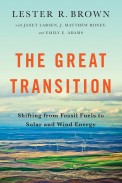Tuesday, November 13, 2012
One of the many things we love about Lester Brown’s Full Planet, Empty Plates is its readability. The book is only 160 pages with graphs and tables to provide visuals of the discussion. In his review, Jeff McIntire-Strasburg of Sustainablog wrote, “As with all of Brown’s books, Full Planet, Empty Plates is very well-documented: over 150 data sets accompany the book. Brown fully explains the extent of food challenges in various regions of the globe, and the potential impacts based on environmental and socioeconomic factors in these regions.”
As we said last week, we at Earth Policy Institute like to offer an array of options for our research to reach as wide an audience as possible. Here are a few quick facts to get you thinking about the global food crisis:
-
There will be 219,000 people at the dinner table tonight who were not there last night—many of them with empty plates.

- As a result of chronic hunger, 48 percent of all children in India are undersized, underweight, and likely to have IQs that are on average 10-15 points lower than those of well-nourished children.
- Food prices are rising dramatically. The U.N. Food Price Index in June 2012 was twice the base level of 2002-04.
- More than half the world’s people live in countries where water tables are falling as aquifers are being depleted.
- A startling 80 percent of oceanic fisheries are being fished at or beyond their sustainable yield.
- Between 2005 and 2011, the amount of grain used to produce fuel for cars in the United States climbed from 41 million to 127 million tons—nearly a third of the U.S. grain harvest.
- In 2011, China consumed 70 million tons of soybeans, 56 million of which had to be imported. Almost all went into livestock feed.
- Today, with incomes rising fast in emerging economies, there are at least 3 billion people moving up the food chain, consuming more grain-intensive livestock and poultry products.
- Data for India indicate that 175 million people are being fed with grain produced by overpumping. For China, there are 130 million in the same boat.
- In Ethiopia, a prime target for foreign land acquisitions yet also a major food aid recipient, an acre of land can be leased for less than $1 per year.
- The 464 land acquisitions identified by the World Bank in 2010 totaled some 140 million acres—more than is planted in corn and wheat combined in the United States.
- It’s not all bad news: 44 countries have reached population stability as a result of gradual fertility decline over the last several generations.
Even quicker is the video of Brown himself discussing the main issues raised in the book.
Enjoy!
Julianne
Monday, November 05, 2012
The written word is a wonderful way to communicate ideas, but to reach out as widely as possible, we at Earth Policy Institute like to offer an array of options for our research.
Take a look at this five-minute video where Lester Brown speaks on some of the major topics covered in Full Planet, Empty Plates.
We have also uploaded two Power Point presentations providing graphic and textual highlights from the book.
And we are working on short video clips on some of the specific issues raised in the book.
Happy viewing!
Cheers,
Reah Janise Kauffman
Page 1 of 1 pages


